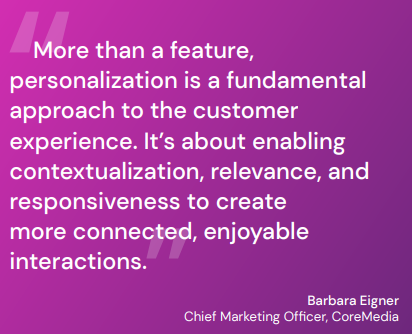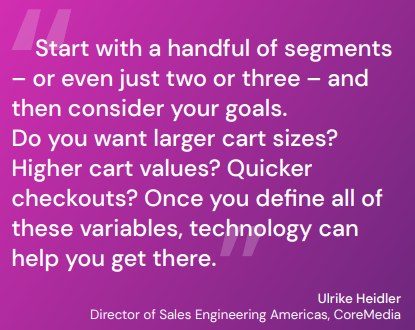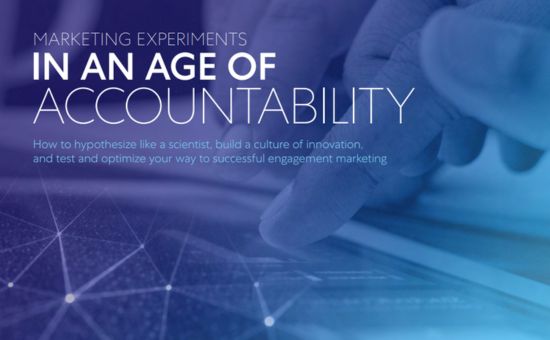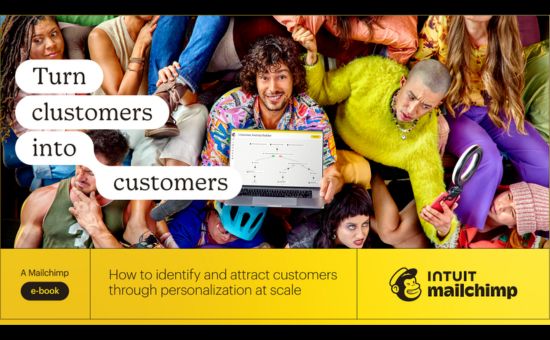Busting the 5 most common personalization myths | Core Media
Personalization
Conversely, those mastering personalization see a 40% revenue boost. Yet, numerous organizations struggle with ineffective personalization despite 85% believing they deliver tailored experiences, reveals Twilio research. Discover the essence of personalization, debunk myths, and gain strategies to surpass customer expectations, fostering enduring loyalty in this paper.
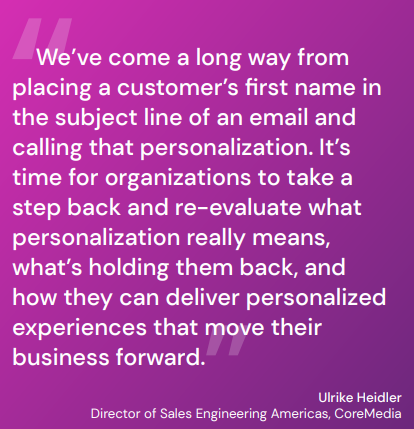
What is personalization?
Personalization entails delivering tailored customer experiences precisely timed within the customer journey, devoid of unnecessary manual intervention. It harnesses behavioral, situational, historical, predictive, and social data to offer real-time online and in-store experiences that capture consumer attention, nurture relationships, instill trust, and drive revenue.
Examples include personalized product recommendations, customized messaging, targeted promotions, post-sale follow-ups, and content aligned with consumer behavior. Micro-moments, crucial in personalization, occur when customers engage with devices for specific purposes like purchasing or learning.
According to McKinsey, 59% of customers seek communications aligned with these key moments. Brands can seize micro-moments to deliver timely value, be it through special offers, informative content, or delightful experiences.
Biggest myths and how to overcome them
Personalization starts with technology.
While technology facilitates progress, many marketers prioritize it over strategy. Understanding your current position and goals is crucial for effective personalization. Start by analyzing customer behavior—purchase timing, site engagement, cart contents, and purchase size—to segment your audience.
Segments may be based on demographics, geography, personality, or behaviors. Tailor content for each segment; for instance, promote backpacks to mothers shopping for back-to-school items. Later, upsell coordinating products like lunchboxes. For segments making quick decisions, offer aggressive promotions to capture purchases before interest wanes.
Personalization is one-and-done.
Each time a consumer contemplates a purchase, they embark on a fresh buying journey, influenced by evolving preferences or external factors like weather changes. Therefore, personalization is an ongoing endeavor. Rather than merely launching targeted campaigns, it involves testing, optimizing, and measuring success iteratively.
Begin by segmenting email subscribers based on location or behaviors for tailored email campaigns. Progress to segmenting social media audiences by interests, age, or demographics to deliver relevant content. Leverage web analytics to inform blog and page content creation, experimenting with various messages and calls to action. Despite the complexity, several strategies ensure teams consistently provide desired content:
- Utilize customer segmentation lists from eCommerce, marketing automation, or CRM platforms to personalize content and product offerings. AI-driven personalization tools can automate segment generation, saving time and ensuring alignment with current audience data.
- Implement content rules supported by user data within the CMS to determine when different content elements are displayed. This enables scheduled content deployment, ensuring the timely delivery of tailored messages aligned with audience preferences and behaviors.
- Empower teams to preview and test content by persona and contextual factors before publishing. Editors should have the capability to preview content based on various parameters such as persona, device, season, or weather conditions, ensuring seamless content delivery across omnichannel platforms.
Personalization requires a large team and lots of manual work.
Undoubtedly, personalization is intricate, demanding strategic planning and continuous dedication. While initial setup involves some manual labor, leveraging technology can streamline efforts. Advanced tools utilizing AI and machine learning are increasingly adept at automating tasks and minimizing human intervention.
On the content front, personalization doesn’t necessitate a large team or extensive content creation for every audience segment. Through content reuse and seamless integration of content and commerce, teams of any size can excel in personalization.
For instance, catering to multiple regions requires tailored content reflecting language, regulations, and customs. Instead of crafting each variant separately, a proficient CMS enables text and image reuse, alongside automated translations, fostering efficiency and relevance.
Integrating personalized shoppable content into images, stories, banners, or blog posts with minimal manual input should be effortless. A modern CMS facilitates drag-and-drop product integration into rich media while retrieving real-time pricing data with inventory awareness, enhancing productivity, and enriching customer experiences.
Every piece of content should be personalized.
Despite the advantages of personalization, organizations must strike a balance between delivering targeted content and empowering customers to control their shopping experience. Consider this scenario:
A man is browsing his favorite sporting goods site for a skateboard for his son. While he receives tailored recommendations for skateboard models and accessories, after completing the purchase, he continues to encounter skateboard-related items instead of the golf equipment he’s interested in. Although the skateboard content was personalized to his specific journey, the retailer missed an opportunity to sell him the items he truly desired.
To address this, organizations can implement strategies to enable customers to explore their product range while enhancing their experience and preserving their privacy. Providing “personalization exits” fosters trust:
- Allow anonymous shopping to respect privacy.
- Offer opt-out options for certain shopping activities in the customer profile.
- Implement randomized recommendations to broaden options and potentially increase future purchases.
- Blend dynamic product listings with manually curated content, such as teasers for relevant blog posts or promotions for new products, to diversify the shopping experience.
- Showcase items purchased by other customers, leveraging peer influence.
- Incentivize purchases with dynamic listings featuring recently purchased items.
By incorporating these approaches, organizations can strike a harmonious balance between personalization and customer autonomy, fostering trust and improving the overall shopping experience.
Privacy regulations limit the ability to personalize experiences.
Some marketers perceive consumer privacy regulations such as the General Data Protection Regulation (GDPR) and the California Consumer Privacy Act (CCPA) as obstacles to achieving personalization. However, these regulations mandate businesses to obtain consumer consent before collecting their data, thereby enhancing trust by ensuring transparency in data usage.
Research indicates that most consumers are willing to provide consent if they anticipate receiving personalized, authentic, and engaging experiences. In addition to complying with privacy regulations, you can further bolster consumer privacy and trust by personalizing experiences based on contextual factors like weather or location, rather than relying on sensitive personal details.
Providing consumers with the option to specify which data they wish to share and for what purpose, and ensuring clear communication regarding data usage, also contributes to increased trust.
Shatter the myths. Pull ahead with personalization.
Providing tailored experiences can determine whether a customer remains loyal or opts for alternative options. By comprehending the essence of personalization, its anticipated benefits, and potential challenges, you can formulate a successful strategy to elevate your campaigns and revenue.
Discover the Key to Tailored Experiences! Download our comprehensive guide to unlock the potential of customized interactions and elevate your campaigns for increased revenue and customer loyalty.
The Table of Contents of “Busting the 5 most common personalization myths” Guide:
- What is personalization?
- Biggest personalization myths and how to overcome them
- Personalization starts with technology.
- Personalization is one-and-done.
- Personalization requires a large team and lots of manual work.
- Every piece of content should be personalized.
- Privacy regulations limit the ability to personalize experiences.
- Shatter the myths. Pull ahead with personalization.
Number of Pages:
- 9 pages
Pricing:
- Free
Warning: Undefined array key "sidebar_ads" in /home/dmc/public_html/wp-content/themes/DMC/functions/helpers.php on line 824
